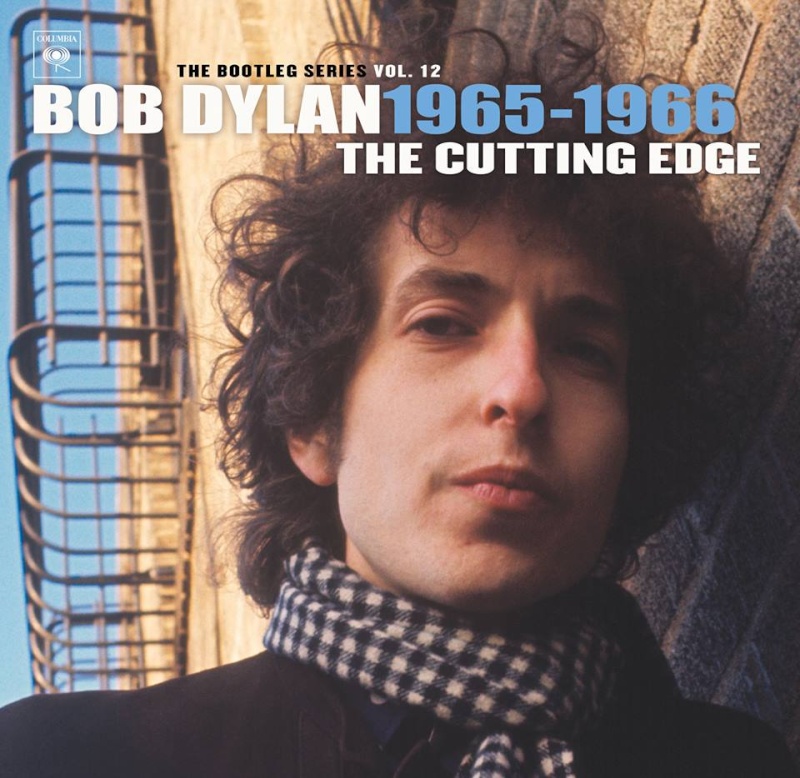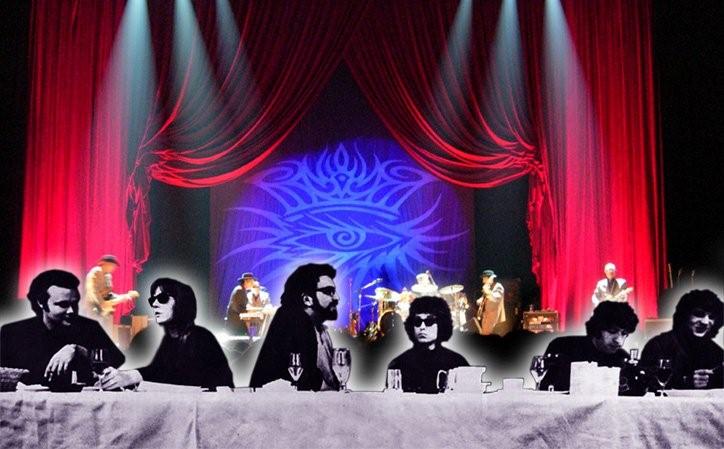
The Best of The Cutting Edge 1965–1966: The Bootleg Series Vol. 12 Track List
Disc 1:
1. "Love Minus Zero/No Limit" - Take 1 (1/13/1965) acoustic, incomplete
2. "Love Minus Zero/No Limit" - Take 2 (1/13/1965) acoustic
3. "Love Minus Zero/No Limit" - Take 3 remake (1/13/1965) acoustic
4. "Love Minus Zero/No Limit" - Take 1 remake (1/14/1965) electric
5. "I'll Keep It with Mine" - Take 1 (1/13/1965) piano demo, previously released on Biograph, 1985
6. "It's All Over Now, Baby Blue" - Take 1 (1/13/1965) solo acoustic, previously released on The Bootleg Series, Vol. 7, 2005
7. "Bob Dylan's 115th Dream" - Take 1 (1/13/1965) acoustic, incomplete
8. "Bob Dylan's 115th Dream" - Take 2 (1/13/1965) acoustic
9. "She Belongs to Me" - Take 1 (1/13/1965) solo acoustic
10. "She Belongs to Me" - Take 2 Remake (1/13/1965) acoustic
11. "She Belongs to Me" - Take 1 Remake (1/14/1965) electric
12. "Subterranean Homesick Blues" - Take 1 (1/13/1965) solo acoustic, previously released on The Bootleg Series, Vol. 1–3, 1991
13. "Subterranean Homesick Blues"- Take 1 remake (1/14/1965) electric
14. "Outlaw Blues" - Take 1 (1/13/1965) solo acoustic
15. "Outlaw Blues" - Take 2 Remake (1/13/1965) electric
16. "On the Road Again" - Take 1 (1/13/1965) solo acoustic
17. "On the Road Again" - Take 4 (1/14/1965) electric
18. "On the Road Again"- Take 1 remake (1/15/1965) electric
19. "On the Road Again" - Take 7 remake (1/15/1965) electric
20. "Farewell, Angelina" - Take 1 (1/13/1965) solo acoustic, previously released The Bootleg Series, Vol. 1–3, 1991
21. "If You Gotta Go, Go Now" - Take 1 (1/13/1965) solo acoustic
22. "If You Gotta Go, Go Now" - Take 2 (1/15/1965) electric
23. "You Don't Have to Do That" - Take 1 (1/13/1965) solo acoustic, incomplete
Disc 2:
1. "Tombstone Blues" - Take 1 (7/29/1965) alternate take
2. "Positively 4th Street" - Take 5 (7/29/1965) alternate take
3. "Can You Please Crawl Out Your Window"- Take 1 (7/30/1965) alternate take
4. "Just Like Tom Thumb's Blues" - Take 3 (8/2/1965) rehearsal
5. "Highway 61 Revisited" - Take 3 (8/2/1965) alternate take
6. "Queen Jane Approximately" - Take 5 (8/2/1965) alternate take
7. "Visions of Johanna" - Take 5 (11/30/1965) rehearsal
8. "She's Your Lover Now" - Take 6 (1/21/1966) rehearsal
9. "Lunatic Princess" - Take 1 (1/27/1966)
10. "Leopard-Skin Pill-Box Hat" - Take 8 (2/14/1966) alternate take
11. "One of Us Must Know (Sooner or Later)" - Take 19 (1/25/1966) alternate take
12. "Stuck Inside of Mobile With the Memphis Blues Again" - Take 13 (2/17/1966) alternate take
13. "Absolutely Sweet Marie" - Take 1 (3/7/1966) alternate take
14. "Just Like a Woman" - Take 4 (3/8/1966) alternate take
15. "Pledging My Time" - Take 1 (3/8/1966) alternate take
16. "I Want You" - Take 4 (3/10/1966) alternate take
17. "Highway 61 Revisited" – Take 7 (8/2/1965) false start
All tracks previously unreleased except Disc 1, track 2, Biograph; Disc 1, track 8, The Bootleg Series, Volume 1–3.

The Cutting Edge 1965–1966: The Bootleg Series Vol. 12 (6CD Deluxe Edition) Track List
Disc 1:
1. "Love Minus Zero/No Limit" - Take 1 (1/13/1965) acoustic, incomplete
2. "Love Minus Zero/No Limit" - Take 2 (1/13/1965) acoustic
3. "Love Minus Zero/No Limit" - Take 3 remake (1/13/1965) acoustic
4. "Love Minus Zero/No Limit" - Take 1 remake (1/14/1965) electric
5. "I'll Keep It with Mine" - Take 1 (1/13/1965) piano demo, previously released on Biograph, 1985
6. "It's All Over Now, Baby Blue" - Take 1 (1/13/1965) solo acoustic, previously released on The Bootleg Series, Vol. 7, 2005
7. "Bob Dylan's 115th Dream" - Take 1 (1/13/1965) acoustic, incomplete
8. "Bob Dylan's 115th Dream" - Take 2 (1/13/1965) acoustic
9. "She Belongs to Me" - Take 1 (1/13/1965) solo acoustic
10. "She Belongs to Me" - Take 2 Remake (1/13/1965) acoustic
11. "She Belongs to Me" - Take 1 Remake (1/14/1965) electric
12. "Subterranean Homesick Blues" - Take 1 (1/13/1965) solo acoustic, previously released on The Bootleg Series, Vol. 1–3, 1991
13. "Subterranean Homesick Blues" - Take 1 remake (1/14/1965) electric
14. "Outlaw Blues" - Take 1 (1/13/1965) solo acoustic
15. "Outlaw Blues" - Take 2 Remake (1/13/1965) electric
16. "On the Road Again" - Take 1 (1/13/1965) solo acoustic
17. "On the Road Again" - Take 4 (1/14/1965) electric
18. "On the Road Again" - Take 1 remake (1/15/1965) electric
19. "On the Road Again" - Take 7 remake (1/15/1965) electric
20. "Farewell, Angelina" - Take 1 (1/13/1965) solo acoustic, previously released The Bootleg Series, Vol. 1–3, 1991
21. "If You Gotta Go, Go Now" - Take 1 (1/13/1965) solo acoustic
22. "If You Gotta Go, Go Now" - Take 2 (1/15/1965) electric
23. "You Don't Have to Do That" - Take 1 (1/13/1965) solo acoustic, incomplete
Disc 2:
1. "California" - Take 1 (1/13/1965) solo acoustic
2. "It's Alright, Ma (I'm Only Bleeding)" - Take 1 (1/15/1965) acoustic, demo
3. "Mr. Tambourine Man" - Takes 1 - 2 (1/15/1965) incomplete, with band
4. "Mr. Tambourine Man" - Take 3 (1/15/1965) incomplete, with band
5. "It Takes a Lot to Laugh, It Takes a Train to Cry" - Take 1 (6/15/1965)
6. "It Takes a Lot to Laugh, It Takes a Train to Cry" - Take 8 (6/15/1965)
7. "It Takes a Lot to Laugh, It Takes a Train to Cry" - Take 3 (7/29/1965)
8. "It Takes a Lot to Laugh, It Takes a Train to Cry" - Take 3 remake (7/29/65)
9. "Sitting on a Barbed Wire Fence" - Take 2 (6/15/1965)
10. "Tombstone Blues" - Take 1 (7/29/1965)
11. "Tombstone Blues" - Take 9 (7/29/1965) previously released on The Bootleg Series, Vol. 7, 2005
12. "Positively 4th Street" - Takes 1–3 (7/29/1965)
13. "Positively 4th Street" - Take 4 (7/29/1965)
14. "Positively 4th Street" - Take 5 (7/29/1965)
15. "Desolation Row" - Take 1 (8/4/1965)
16. "Desolation Row" - Take 2 (8/4/1965) piano demo
17. "Desolation Row" - Take 5 remake (8/2/1965)
18. "From a Buick 6" - Take 1 (7/30/1965)
19. "From a Buick 6" - Take 4 (7/30/1965) released in error on first pressing of Highway 61 Revisited, 1965
Disc 3:
1. "Like a Rolling Stone" - Take 1–3 (6/15/1965)
2. "Like a Rolling Stone" - Take 4 (6/15/1965)
3. "Like a Rolling Stone" - Take 5 (6/15/1965)
4. "Like a Rolling Stone" - Rehearsal (6/16/1965)
5. "Like a Rolling Stone" - Take 1 (6/16/1965)
6. "Like a Rolling Stone" - Takes 2-3 (6/16/1965)
7. "Like a Rolling Stone" - Take 4 (6/16/1965) released on Highway 61 Revisited, 1965
8. "Like a Rolling Stone" - Take 5 (6/16/1965)
9. "Like a Rolling Stone" - Take 6 (6/16/1965)
10. "Like a Rolling Stone" -Take 8 (6/16/1965)
11. "Like a Rolling Stone" - Takes 9-10 (6/16/1965)
12. "Like a Rolling Stone" - Take 11 (6/16/1965)
13. "Like a Rolling Stone" - Take 12 (6/16/1965)
14. "Like a Rolling Stone" - Take 13 (6/16/1965)
15. "Like a Rolling Stone" - Take 14 (6/16/1965)
16. "Like a Rolling Stone" - Take 15 (6/16/1965)
17. "Like a Rolling Stone" - Master take - lead guitar isolated track
18. "Like a Rolling Stone" - Master take - vocal and guitar isolated track
19. "Like a Rolling Stone" - Mast take - drums and organ isolated track
20. "Like a Rolling Stone" - Master take - piano and bass isolated track
Disc 4:
1. "Can You Please Crawl Out Your Window" - Take 1 (7/30/1965)
2. "Can You Please Crawl Out Your Window" - Take 17 (7/30/1965 released in error on the first pressing of "Positively 4th Street" single
3. "Highway 61 Revisited" - Take 3 (8/2/1965)
4. "Highway 61 Revisited" - Take 5 (8/2/1965)
5. "Highway 61 Revisited" - Take 7 (8/2/1965)
6. "Just Like Tom Thumb's Blues" - Take 1 (8/2/1965)
7. "Just Like Tom Thumb's Blues" - Take 3 (8/2/1965)
8. "Just Like Tom Thumb's Blues" - Take 13 (8/2/1965)
9. "Queen Jane Approximately" - Take 2 (8/2/1965)
10. "Queen Jane Approximately" - Take 5 (8/2/1965)
11. "Ballad of a Thin Man" - Take 2 (8/2/1965) incomplete
12. "Medicine Sunday" - Take 1 (10/5/1965)
13. "Jet Pilot" - Take 1 (10/5/1965) Previously released on Biograph, 1985
14. "I Wanna Be Your Lover" - Take 1 (10/5/1965)
15. "I Wanna Be Your Lover" - Take 6 (10/5/1965)
16. "Unknown Instrumental" - Take 2 (10/5/1965)
17. "Can You Please Crawl Out Your Window" - Takes 5-6 (11/30/1965)
18. "Visions of Johanna" - Take 1 (11/30/1965)
19. "Visions of Johanna" - Take 5 (11/30/1965)
Disc 5:
1. "Visions of Johanna" - Take 7 (11/30/1965)
2. "Visions of Johanna" - Take 8 (11/30/1965) previously released on The Bootleg Series, Vol. 7, 2005
3. "Visions of Johanna" - Take 14 (11/30/1965)
4. "She's Your Lover Now" - Take 1 (1/21/1966)
5. "She's Your Lover Now" - Take 6 (1/21/1966)
6. "She's Your Lover Now" - Take 15 (1/21/1966) previously released on The Bootleg Series, Vol. 1–3, 1991
7. "She's Your Lover Now" - Take 16 (1/21/1966) solo piano
8. "One of Us Must Know (Sooner or Later)" - Take 2 (1/25/1966)
9. "One of Us Must Know (Sooner or Later)" - Take 4 (1/25/1966)
10. "One of Us Must Know (Sooner or Later)" - Take 19 (1/25/1966)
11. "Lunatic Princess" - Take 1 (1/27/1966)
12. "Fourth Time Around" - Take 11 (2/14/1966)
13. "Leopard-Skin Pill-Box Hat" - Take 3 (2/14/1966)
14. "Leopard-Skin Pill-Box Hat" - Take 8 (2/14/1966)
Disc 6:
1. "Stuck Inside of Mobile With the Memphis Blues Again" - Take 1 (2/17/1966)
2. "Stuck Inside of Mobile With the Memphis Blues Again" - Rehearsal (2/17/1966)
3. "Stuck Inside of Mobile With the Memphis Blues Again" - Take 5 (2/17/1966) previously released on The Bootleg Series, Vol. 7, 2005
4. "Stuck Inside of Mobile With the Memphis Blues Again" - Take 13 (2/17/1966)
5. "Stuck Inside of Mobile With the Memphis Blues Again" - Take 14 (2/17/1966)
6. "Absolutely Sweet Marie" - Take 1 (3/7/1966)
7. "Just Like a Woman" - Take 1 (3/8/1966)
8. "Just Like a Woman" - Take 4 (3/8/1966)
9. "Just Like a Woman" - Take 8 (3/8/1966)
10. "Pledging My Time" - Take 1 (3/8/1966)
11. "Most Likely You Go Your Way (And I'll Go Mine)" - Take 1 (3/9/1966)
12. "Temporary Like Achilles" - Take 3 (3/9/1966)
13. "Obviously 5 Believers" - Take 3 (3/10/1966)
14. "I Want You" - Take 4 (3/10/1966)
15. "Sad-Eyed Lady of the Lowlands" - Take 1 - (2/16/1966)
